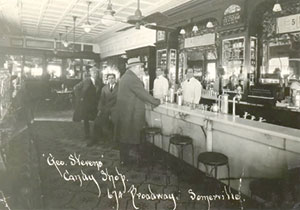
The virtual “Bittersweet” event hosted by the Somerville Museum explores the rich history of candy production and consumption in Somerville and its environs.
By Ryan DiLello
The Somerville Museum released a recording of the latest event for its ongoing Bittersweet exhibit. The virtual event, which examined the modern history of candy manufacturers in the greater Boston metro area, centered around a presentation from Jeremy Spindler, co-founder of Spindler Confections in North Cambridge. In addition to churning out an impressive assortment of sugary goods, Spindler and his partner Jeremy Meyers take pride in owning more than 300 artifacts linked to the candy industry.
The meeting kicked off with an introduction from Bittersweet curator, Santiago Montoya. Co-curator, Jose Falconi, was unable to attend the evening’s event. Montoya provided a brief overview of the exhibit before Jeremy Spindler launched into his presentation. Readers can learn more about the Bittersweet project at: http://www.thesomervilletimes.com/archives/114638.
“When you walk around Boston today, unless you know the history and you know what to look for, you would have no idea the [candy] industry existed here,” Spindler began.
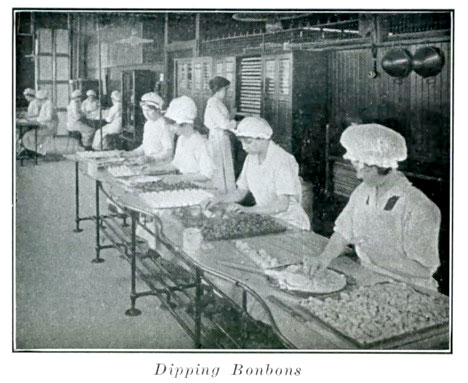
Local factory workers give Bonbons their chocolate shell.
According to Spindler, the Boston area was home to 140 candy factories. “These were not cute mom and pop shops,” Spindler clarified, “these were multi-level factories.”
Data from the New England Manufacturing Confectioners Association provided a breakdown of candy production sales on a yearly basis. As Spindler noted, differences in currency conversions from then to today vary due to inflation.
- 1889: $5,800,000.00 (ca. 196 million today)
- 1913: $20,000,000.00 (ca. 550 million today)
- 1926: $50,000,000.00 (760 million today)
- 1965: $188,00,00.00 (ca. 1.6 billion today)
Spindler said the candy industry in the greater Boston area peaked around 1965, with over 360 million pounds of products. Around that time, the largest factories could push out up to 300,00 pounds of product a day, or 90,000,000 pounds per year at capacity (such as around the holiday season).
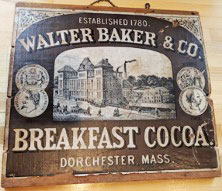
Walter Baker and Co. established in Dorchester in 1780.
But why was candy such a popular product in Boston and its neighboring cities? Spindler provided several reasons. The first “Puritans had a sweet tooth.” When they came over to the States, they were determined to keep satisfying it. Perhaps more pragmatically speaking, the Boston area was a central port for imported goods, making it a hotbed for industrial development. And interestingly, climate played an important role as chocolate production necessitated cold weather. In New England, candy manufacturers could produce 10 months a year – that wasn’t possible in the South.
Thus, in 1764, the first chocolate mill in the country opened in Dorchester, Massachusetts, followed by the first refinery in 1834 in East Boston. Then 1847 the first candy making machine was invented in Boston, then that same inventor started Chase & Co. in 1847, the first confectionery company in the country. By 1878, according to the Boston Business Directory List, there were 39 confectionery manufacturers, 2 chocolate manufacturers, and 80 confectionery shops.
Spindler discussed the history of a few prominent shops beginning with those in Cambridge, followed by Boston and then Somerville.
Cambridge boasted “Confectioner’s Row,” a stretch about three quarters of a mile from Central to Kendall, teaming with candy manufacturers, wholesalers, shops, and packaging centers.
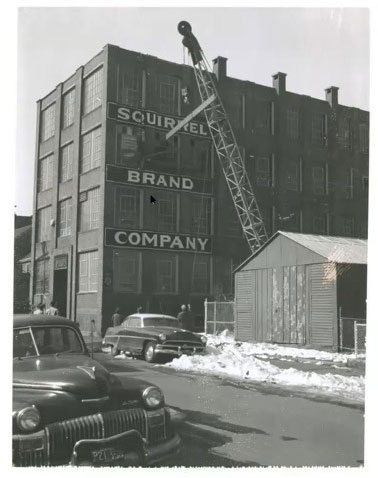
The Squirrel Brand Company building.
Between 1953-1954, Cambridge had 38 manufacturers, 8 wholesalers, and 37 chocolate shops and ice cream parlors. Today, the city has only one manufacturer (which makes Junior Mints), and 8 chocolate shops. “I think we’ve had a shift in culture,” Spindler said, and noted coffee has taken over with 33 coffee shops in Cambridge alone. Just short of half are Dunkin’ Donuts.
Cambridge was home to many candy establishments, but Page and Shaw was a major one. Founded in 1888 as a small shop in Boston, the company moved to a larger factory in 1911, located on Ames Street, right off of Main Street.
In 1920, an investor named Otis Emerson acquired control of the company and grew it into one of the largest in the world with locations in the bustling city centers of London, Paris, Montreal, and New York. Sales peaked in 1924 then suffered a steep decline as demand for chocolate fell during the depression.
In 1930, the U.S. Federal Government found Otis Emerson and two fellow stock brokers guilty of fraud. They were issuing legitimate stock at two dollars a share, then pocketing the money. A year later, Dagget, a candy manufacturer who happened to be next-door neighbors with Page and Shaw, bought the company out but continued making their products. 30 years later, in 1960, Necco purchased Dagget and discontinued the Page and Shaw product line. Page and Shaw were just one of many companies Necco purchased, revived, then took down with them. In 2018, Necco shut down its own production and sold off its intellectual property.
Squirrel Nut Company was another iconic manufacturer which made nut-based sweets. “If you grew up in the [Cambridge] area, I
guarantee you knew the Squirrel nut brand,” Spindler said.
The building still exists today, now serving as a condominium residence, but developers preserved the original signage.
Founded in 1888 as the Austin T. Merrill Company, Squirrel Nut Company rebranded in 1899. In 1903, the company relocated to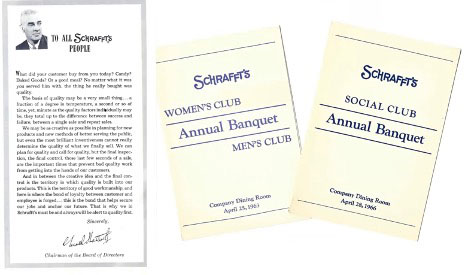 Cambridge and thrived for nearly 100 years. In 1999, Southern Style Nuts, a company based in Texas, bought out the Squirrel brand. Only 4 years later, Necco purchased the company. Then, in 2018, John B. Sanflippo & Sons purchased the intellectual property at auction and still make Squirrel Brand nuts today.
Cambridge and thrived for nearly 100 years. In 1999, Southern Style Nuts, a company based in Texas, bought out the Squirrel brand. Only 4 years later, Necco purchased the company. Then, in 2018, John B. Sanflippo & Sons purchased the intellectual property at auction and still make Squirrel Brand nuts today.
Boston-based Schrafft’s was the largest candy factory in the world at 1,600 employees. Founded by William Schrafft in 1861, the company made candies, chocolates, and cakes – operating through stores, ice cream parlors and even restaurants. The company evolved into a social establishment, complete with a club, frequent exclusive parties, and events featuring original musicals. Schrafft’s also outsourced marketing initiatives to journalists that compiled 30-35-page long news briefs that featured updates from the company.
The company went through several owners before closing in March of 1981 due to a recession. Over 800 workers lost their jobs.
Other honorable mentions included Lovell and Covel, originally located on 122-140 Fulton Street in Boston in 1922 before moving to 254 Massachusetts Ave in Cambridge in 1954. F.H. Roberts, which made Apollo Chocolates, was located on 128 Cross Street in Boston. Necco eventually purchased both companies.
As for confectioneries in Somerville, “There were not very many,” Spindler said. “We know of two.” Those are the New England Maple Syrup Company and a bigger manufacturer, Kemps, which was located on 19 Walnut Street in Somerville and founded in 1912. That building still remains.
Somerville does, however, have a considerable claim to fame: Archibalt Query invented Fluff in the city in 1917.
By the 1940s, Daggett and Necco owned all the companies in Cambridge (where the majority of candy manufacturers were based) and manufacturing in New England was declining. Air conditioning and growing international trade allowed manufacturing to expand across the globe, and history saw the rise of mega producers like M&M/Mars, Hersheys, Nestle, Cadbury, and others.
Today, the charm of candies exists within smaller brick-and-mortar shops like Spindler’s own. Spindler and his coworkers churn out sweets made by hand, and are eager to discuss and share their accumulated artifacts with customers. Spindler welcomes you to stop by the shop, located at 2257 Massachusetts Avenue in Cambridge.
For more information and to see additional photos, watch Spindler’s presentation here: https://www.youtube.com/watch?v=HbPgBFE4r1g.
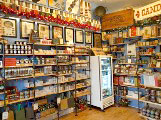
Inside Spindler Confections where candy industry ephemera cover the walls behind sweets for sale.
















Reader Comments